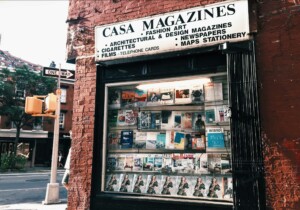Radical Suburbs: Experimental Living on the Fringes of the American City
Amanda Kolson Hurley
Belt Publishing
$16.95
When a book about suburbia contains a chapter called “The Anarchists Who Took the Commuter Train,” you know it is going to be an interesting read. That book is Amanda Kolson Hurley’s Radical Suburbs: Experimental Living on the Fringes of the American City, and it does not disappoint. In six well-researched and informative—yet fast-paced—chapters, Hurley introduces us to a tapestry of suburban social experimentation, from communal living in celibacy to a community of working couples inspired by the Bauhaus. It is a rich collection of projects, most of which have been overlooked by standard urban surveys.
And yes, there were anarchists in Piscataway, New Jersey, commuting to day jobs in Manhattan. Stelton was a development by anarchists decamping from New York’s East Village in 1915. It was centered around an experimental school, the Modern School, which had both year-round and summer residents united by ultraleft political beliefs and, apparently, a love of argumentation. As throughout the book, Hurley takes her research of Piscataway and the Stelton development on the road, visiting the remnants of the town and interviewing former Stelton residents who remember idyllic school days where—as you can imagine in an anarchist paradise—they were pretty much allowed to do anything they liked. Hurley tells Stelton’s story in rich detail, examining everything from how property rights were handled to the ways in which the houses were decorated.
The chapter on Concord Park, which is just outside of Philadelphia, is equally illuminating. Subtitled “Integrating the Suburbs at ‘Checkerboard Square,’” this section details the efforts of a white developer, Morris Milgram, to create a completely integrated suburb in the 1950s. Hurley effectively conveys the many hurdles Milgram faced and the agonizing choices he had to make, most notably his decision to mandate a quota of 55 percent sales to whites and 45 percent to blacks. As one of only a handful of suburban communities to offer high-quality homes to black residents, the quota was deemed necessary in order to keep it from becoming majority black, with the 10 percent disparity added to entice whites to buy. The project was an initial success (it later did revert to an upper-middle-class majority black neighborhood). Hurley again found authentic voices of former residents, combined with tireless research, to record its story.
All of the stories in this book are masterfully told, adding depth to the examination of suburbs within the disciplines of urbanism and architecture—while at the same time providing enough color and commentary to appeal to a reader with little experience or prior interest in the subject. Hurley’s focus on social experimentation and the ways developments affected residents’ day-to-day lives is part of this success.
What gets perhaps less attention, however, is the wonkier architectural-urban analyses of urban design and architecture in contributing to the radicality of these projects. Of the two more “architectural” projects detailed in the book, The Architects’ Collaborative’s collection of Modernist homes outside of Cambridge, Massachusetts, and the planned city of Reston, Virginia—the dreamchild of developer Robert E. Simo designed by William Conklin and Thomas Rossant—which only Reston could be considered a truly radical challenge to the standard subdivision in terms of its urban design, embracing both density and mixing of uses. Even at Reston, Simon was forced out and the project reverted to typical suburban norms. (The knife in the gut is that the companies that took over the project were Gulf Oil and Mobil—as if we needed any further proof of what oil companies are looking for in terms of how people live and commute.)
As a result, the book is rather short on critical analysis of the role of design and, perhaps more important, whether design can play a role in remedying any of the problems—restrictive covenants, lack of density and connections, the effects of climate change—that Hurley details in her conclusion as everyday realities. As many—if not most—of the projects in the book ended up failing in themselves or at least failing to inspire any larger movements, the role of design in the relative success of an example like Greenbelt, Maryland—where the proto-modernist forms of Art Deco were used to create a successful mingling of a main street with true suburban freedoms—would make for an interesting next volume.
Hurley’s organization of the book reflects this dichotomy between what is considered success and what is considered failure. She begins in the introduction with a full-throated defense of the suburbs, detailing their increased diversity, quality of life, and sense of community, arguing that the examples in the book are a refutation of suburban clichés of conformity, mediocrity, and blandness. Yet she ends with the aforementioned critique and offers a list of ways in which suburbs could improve. Even the most ordinary of suburbs can of course be considered a uniquely American experiment that has had extraordinary success in redefining how people live. As with any experiment, it is the failures that often provide the pathway to new solutions, and Hurley shows how a number of outliers previously lost to history offer clear alternatives. With 50 percent of Americans still living in the suburbs, even the most hardcore urbanist cannot refute the need to reexamine and redesign them. Hurley has provided us with much-needed fuel for the imagination.
Dan Wood, FAIA, is a cofounder of WORKac and author of We’ll Get There When We Cross That Bridge and 49 Cities.











